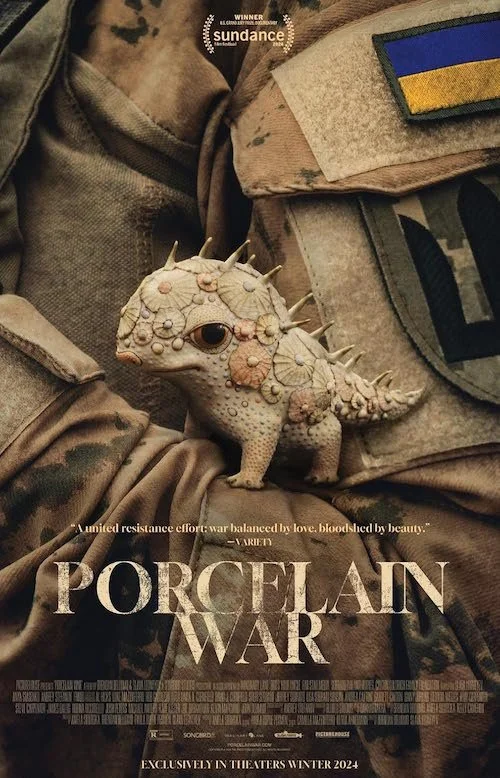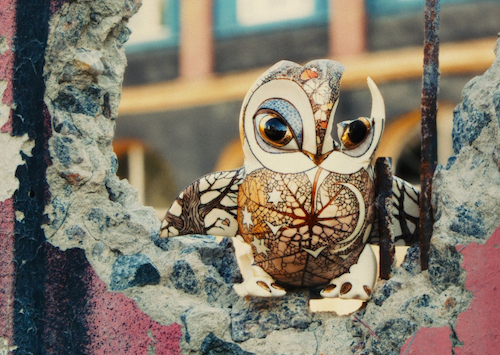Porcelain War
Written by Andreas Babiolakis
It goes without saying that the devastation that is still ongoing in Ukraine is beyond description. As they say, pictures are worth a thousand words, and that must mean that motion pictures can aid us in detailing the extent of an event as crushing as Russia’s brute-force occupation of Ukraine. Last year’s Best Documentary Feature Film winner at the 96th Academy Awards, 20 Days in Mariupol, planted us right in the middle of what a group of journalists faced on a regular basis during the earliest days of Russia’s takeover. This year, while the slaughter sadly remains, there is another film that brings us to a different side of this very crisis, and that is the documentary film Porcelain War, which is now up for the very same award that 20 Days in Mariupol won last year. Even though there is clearly no intention for both of these films to be seen together, I do believe that Porcelain War is the yang to 20 Days in Mariupol’s yin; the former’s harmony to the latter’s distress. Of course, what Ukraine and its people are going through is immeasurable. 20 Days in Mariupol shed light on the extents of the obvious. Porcelain War, however, informs us of the very small bits of hope and light within the destruction which honestly feel impossible (and, yet, here they are in full effect).
Three members of the Ukrainian defense team, Slava Leontyev (who is a co-director of this film with Brendan Bellomo), Anya Stasenko, and Andrey Stefanov not only fight for their country but also try to preserve both the beauty and culture of their motherland. Outside of their efforts on the front lines, they express their love for Ukraine and their sadness with what it’s been reduced to via the creation of little porcelain figures: ones which are based on real beings (mainly creatures) with extra artistic flourishes (as if they are the products of a healing, reborn country after the bombing is eventually ceased). These figurines reside in a war-torn country, with the ruins as their backdrop. It’s difficult to explain how these images make me feel, but I can only attempt to liken them to seeing the massive sets of some sort of stop-motion, post-apocalyptic film. While the art warms my soul, it does remind me of the scale of how much bombing has taken place if the vast majority of this nation now looks like this setting I’d find in a science fiction film or video game. Sadly, this is what millions of people call home, and those within Porcelain War are reclaiming it in their own way while finding comfort in the places that once housed their sense of belonging. By the way, these figures are exquisite, and I would absolutely buy some if they were available. I adore their design and what they represent; the film does a great job of making you feel within arm’s reach of them as well.
Porcelain War is a lighter, more hopeful look at the Russian-occupied state of Ukraine, while never dulling down just how difficult living conditions are there.
Porcelain War possesses a whimsy throughout its ninety-minute runtime, as if to bring back childlike innocence to a place that has been stolen of its safety. While never getting sappy, the film often prioritizes the solace and hope found within those who refuse to give up on their country no matter what cost. Having said that, Porcelain War doesn’t shy away from just how bad Russia’s attacks have been. You can even clearly see bombings take place, and they’re shot almost reservedly, as if to say that these attacks are so frequent that they’ve become second nature to those still living in Ukraine (although no one will ever get over the lives cost, the memories stripped, and the land and progress dismantled). The film reminds us that it’s just as important to show those who refuse to stop living in the face of atrocity as it is to focus on the atrocity itself: this is perseverance that describes how resilient and powerful people can be in their darkest hours.
Porcelain War goes as far as it can with its premise. It occasionally becomes a cinematic gallery for the porcelain figures, and they are shot exquisitely. Furthermore, there are a few sequences where these figures have their coats of paint animated, as to tell the complete story of what their markings represent. There are other moments where the bombings are symbolized in artistic ways, including an effective shot of dandelion pappi slowly descending onto the ground and making sounds of muted explosions as they land (signifying drone bombing in a blatant, visceral way). I finally love the use of porcelain as the creation of these beautiful creatures, because the material is highly fragile and indicative of how delicate the people and situation of Ukraine are right now. Even so, the people within Porcelain War are using the rubble to piece back together the place they cherish and are commemorating the loved ones they miss. Porcelain War is a lovely film that both reminds you of the severity of the current state of Ukraine while also giving you faith in the humans who stand up to oppression and massacre, even if in their own way; humbleness can sometimes speak volumes, and such is the case here.
Andreas Babiolakis has a Masters degree in Film and Photography Preservation and Collections Management from Ryerson University, as well as a Bachelors degree in Cinema Studies from York University. His favourite times of year are the Criterion Collection flash sales and the annual Toronto International Film Festival.






